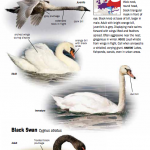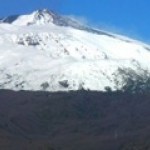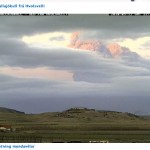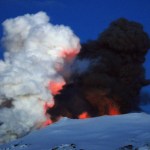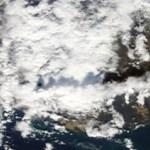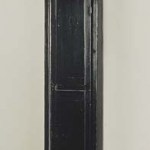Europe
By the time you read this, I will have arrived at an undisclosed location somewhere in Europe. My 25th wedding anniversary is today, and to celebrate my wife and I planned a nearly two-week vacation flitting about Europe. I won't announce where exactly, given that I've irritated a couple of European cranks in recent months, but those of you who are Facebook friends or who follow me on Twitter will likely soon see mentions and/or photos of where we're vacationing.
As this day approached, I contemplated what to do with the blog. I thought about just shutting it down for two weeks, but hesitated…
Just got my copy of Birds of Europe, North Africa, and the Middle East: A Photographic Guide by Frédéric Jiguet and Aurélien Audevard.
This is the first and only field-ready photographic bird guide that covers every species in Europe. There are 2,200 photos covering 860 species. The West Asian and North African coverage is of all of the species there that have occurred in Europe, so think of this primarily as a European guide.
The entry for the Mute Swan.
I hasten to add and emphasize. These are not your grandaddy's photographs. Many photographic guides have pretty nice looking…
A few scientific papers are retracted after they're published, such as this analysis of nuclear energy that appears to have been nixed for poor methodology and bad numbers on Stoat. William M. Connolley adds that because of the politics surrounding nuclear power in Europe, "this crude level of analysis would be unlikely to be useful." But on Respectful Insolence, Orac looks at an anti-vaccine abstract that was so awful the publisher decided to take it down before the paper could be published. Orac writes, "basically, this paper is crap, so much so that even a predatory open access publisher…
Well, Sunday the said we'd have some results on the sprout tests for E. coli O104:H4. Well, so far the results are negative.
The 1st tests from a north German farm suspected of being the source
of an _E. coli_ [O104:H4] outbreak are negative, officials say. Of 40 samples from the farm being examined, they said 23 tested negative.
Officials had said earlier that bean sprouts produced at the farm in Uelzen, south of Hamburg, were the most likely cause of the outbreak. The outbreak, which began 3 weeks ago and is concentrated in Hamburg, has left 22 people dead. Initially, German officials had…
The E. coli story is moving quickly. A news report out today suggests that sprouts might be the culprit (though it should be emphasized that the outbreak strain hasn't been isolated from these vegetables yet):
Mr Lindemann said epidemiological studies all seemed to point to the plant nursery in Uelzen in the state of Lower Saxony, about 100km (62m) south of Hamburg - though official tests had not yet shown the presence of the bacteria there.
"Further evidence has emerged which points to a plant nursery in Uelzen as the source of the EHEC cases, or at least one of the sources," he said.
"The…
Mike has has a great new post up looking at some molecular analyses of the current European outbreak strain. For anyone who hasn't been paying close attention to what's happening across the pond, there's an ongoing outbreak of enterohemorrhagic E. coli (EHEC)--the type of E. coli that includes O157:H7, which has been associated with outbreaks of disease associated with food. The most infamous outbreak was the 1993 Jack-in-the-Box disaster, associated with undercooked hamburgers contaminated with the organism, but there have also been outbreaks associated with contaminated vegetables (such as…
An anonymous guest poster at ClubOrlov makes the case that America isn't a place you want to live - and that Americans should get out of Dodge:
Americans, I have some bad news for you:
You have the worst quality of life in the developed world--by a wide margin.
If you had any idea of how people really lived in Western Europe, Australia, New Zealand, Canada and many parts of Asia, you'd be rioting in the streets calling for a better life. In fact, the average Australian or Singaporean taxi driver has a much better standard of living than the typical American white-collar worker.
I know this…
Etna Week Part 1
Mount Etna - Brief Anatomy of an Exceptional Volcano
By guest blogger Dr. Boris Behncke.
Italy truly deserves to be called "the Cradle of Volcanology" - not only because it hosts virtually all existing types of volcanoes and volcanic rock compositions, and seven of its volcanoes have had confirmed eruptions during the historical period (i.e. the past approximately 2700 years), but also because the earliest surviving eyewitness account of an eruption was written in Italy, the first volcano observatory and the first geothermal power plant were built in Italy, and three…
The skeleton of the Hundsheim rhinoceros, Stephanorhinus hundsheimensis. From Kahlke and Kaiser, 2010.
In any given environment, it might be expected that a generalized or unspecialized species might be less prone to extinction than one which depends upon a narrow temperature range, a peculiar kind of food, or other aspect of natural history which is key to its survival. An herbivorous mammal which can subsist on a variety of grasses, leaves, and other plant foods, for example, may be more likely to survive an ecological disruption than a species tied to foliage which might die back during…
"Dinah", a young female gorilla kept at the Bronx Zoo in 1914. From the Zoological Society Bulletin.
Frustrated by the failure of gorillas to thrive in captivity, in 1914 the Bronx Zoo's director William Hornaday lamented "There is not the slightest reason to hope that an adult gorilla, either male or female, ever will be seen living in a zoological park or garden." Whereas wild adult gorillas were "savage" and "implacable" beasts which could not be captured (a photo of a sculpture included in Hornaday's article depicts a gorilla strangling one man, brandishing another about with its other…
An aerial view of Eyjafjallajökull erupting on May 11, 2010, with the extent of the black ash from the eruption on GÃgjökull clearly evident, along with the cracks in the glacier near the lava flow. Photo from the Icelandic Met Office, by Sigurlaug Hjaltadóttir.
Since this past weekend's disruptions due to Eyjafjallajökull, the air over Europe has cleared and most of the airports in Spain, Portugal and Germany (along with those in Morocco) have reopened. The current ash advisory by the London VAAC looks like it will only effect transatlantic flights and Iceland itself, with the ash cloud…
A shot of the summit area of Eyjafjallajökull, showing the twin steam-and-ash plumes from the lava flow and active vent. Picture taken by Dr. Joseph Licciardi (UNH).
Over the weekend, the newly reinvigorated ash eruptions from Eyjafjallajökull combined with favorable winds meant that ash from the eruption closed airspace over swaths of Europe, including Ireland, Spain, Portugal, Italy, Austria and Germany. These disruptions are continuing into the new week, although most of the disruption is for transatlantic flights. However, the threat of ash is more present than ever, as Ryanair…
The steam plume from a lava flow moving down the slopes of Eyjafjallajökull on May 2, 2010.
A quick note on the activity at Eyjafjallajökull in Iceland: The ash from the ongoing eruption has caused a partial closure of airspace over Ireland from 0600 to 1200 on Tuesday May 4. This is one of the first closures of European airspace since airspace reopened over 10 days ago. This closure is based on the predicted location of ash in flight corridors over Ireland tomorrow.
The Icelandic Met Office has released two interesting updates on the activity at Eyjafjallajökull. The first describes the…
An undated painting of the island volcano of Ischia near the Bay of Naples, Italy.
Guess what? It is the end of the semester (well, school year) here at Denison, so I might be a little busy for the next couple weeks.
Here are some news bits (with special thanks to all who emailed me some of these links):
Boris might have more information or opinion on this, but Italy is back in the news concerning the threat of volcanism to the country. This time the volcano is Ischia, off the coast in the Bay of Naples. Guido Bertolaso of Italy's civil protection agency is quoted as saying that the "magma…
A strombolian eruption in the crater of Eyjafjallajökull, taken on April 19, 2010. Image courtesy of the Icelandic Met Office.
The Eyjafjallajökull eruption in Iceland has been one of the most fascinating eruptions in recent memory - and this is beyond the fact that it is a prime example of a "wired" eruption, where people from around the world can follow every aspect of the eruption from the comfort of their home. What will really be interesting is the political fallout from the six day closure of the airspace over most of Europe due to the ash. If you read the press, you'd think that…
Some very quick notes on Eyjafjallajökull:
Eyjafjallajökull erupting at night on April 17/18, 2010, with impressive incandescent explosions.
European airlines are taking "test flights" to see the effect of the ash on their aircraft in hopes to convince EU officials to reopen airspace. Now, officials from KLM say that everything went fine in their test flight, but I haven't seen any details about flightplans, altitude and all the sorts of info you'd want to see if you want to believe these test flights are representative. However, the president of KLM does have a bit of a point in saying…
The eruptive plume from Eyjafjallajökull taken Holsvelli webcam. Image courtesy of Mattias Larsson.
Sorry to disappoint everyone visiting to blog while they sit at any number of airports around the world, but the eruption at Eyjafjallajökull appears to still be going strong. The Icelandic Met Office is heading up to the volcano to conduct a survey of the crater area to find out (1) what it looks like and (2) how much new water (i.e., ice) is there available for the erupting magma. More water is likely to mean more explosive eruptions in this phreatoplinian style - however, like I…
The ash plume from the 2010 Eyjafjallajökull eruption.
To say that the Eyjafjallajökull eruption has become the most significant volcano-related news story of the year would be an understatement. There has been wall-to-wall coverage on every major media outlet, dissecting everything from the effect of ash on jets, to the effect of ash on people, to wildly premature commentary on the climatic effect of the eruption to the potential place in history of this event. The eruption is affecting a wide swath through society: the European economy may take a hit of billions of dollars due to…
The ash from the Eyjafjallajökull eruption as it spreads over Europe on April 15, 2010.
The newly-subglacial Eyjafjallajökull eruption of 2010 has now begun to be felt outside of Iceland. The ash being thrown into the atmosphere from this explosive phase of the eruption has prompted officials in the United Kingdom, Ireland and Norway to close the airspace above their nations due to the threat that ash poses to jet aircraft. Remember, the silica glass shards that make up most ash can melt inside jet engines, causing them to stall - which could lead to crashing. Luckily, so far we have not…
However time may be measured at the Naval Observatory, the clock seems to tick slowly here when Congress is out of town. -Richard Corrigan
The following is the mostly true (but somewhat fictionalized) story of the first clocks in the Americas. In the 17th Century, the finest clockmakers in the world were Dutch, going back to the time of Christiaan Huygens.
Image: A Dutch Longcase clock, courtesy of The Museum of the Dutch Clock.
Huygens determined that if you allowed a pendulum to swing just a little bit, the period of its swing could be used to keep time to incredible accuracy. By the mid-…
